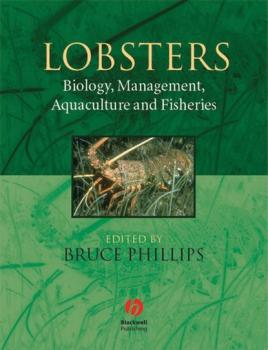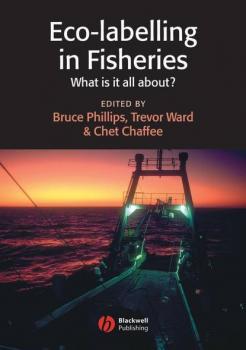ТОП просматриваемых книг сайта:
Bruce Phillips
Список книг автора Bruce PhillipsАннотация
Lobsters are one of the most commercially important groups of animals harvested and farmed throughout the world. Bringing high prices on the market and the table, the results and yields of farmed species has seen continued growth. Under the Editorship of Bruce Phillips an international team of authors provide exhaustive coverage of these fascinating creatures, stretching from growth and development to management and conservation, providing the reader with: Key information for lobster farmers and harvesters Organisation of the species by genera for ease of use Coverage of parasites, pathogens and commensals; their impact, detection and measurement Fisheries scientists, aquaculture personnel, aquatic and invertebrate biologists, physiologists, ecologists, marine biologists and environmental biologists will all find this a vital source of reference. Libraries in universities and research establishments where biological and life sciences and fisheries and aquaculture are studied and taught will find it a valuable addition to their shelves.
Аннотация
SEAFOOD Ecolabelling Principles and Practice Edited by Trevor Ward and Bruce Phillips In recent years there have been some major developments and a greatly increased recognition of the importance of more sustainable and environmentally-friendly fishing and fish-farming methods. Various types of seafood eco-endorsements have been introduced, and these initiatives have now blossomed into an extensive range of types of product endorsement labels and systems. This volume comprehensively reviews the current eco-endorsement systems for seafood products, described in four main sections with contributions by leading experts from around the globe: • A full description of the background and history of ecolabels, ratings, guides and choice systems • Seafood evaluation and certification, including issues of quality, costs and benefits • Highly significant case studies in the use of ecolabels, including details of programs undertaken with species such as Pollock, Baja Red Spiny Lobster, and Patagonian Toothfish • The future of sustainable seafood Seafood Ecolabelling is an essential purchase for all those involved in fisheries and aquaculture management and product certification and ecolabelling throughout the world. Professionals including fishery scientists and managers, fish farm managers, marine biologists, environmental biologists, conservation biologists, ecologists, natural resource managers, civil society and sustainability governance practitioners, and resource and environmental economists will find this book to be extremely valuable. Professionals involved in the seafood trade, including those in production, packaging, reselling and seafood product labelling, will find a great deal of commercial interest within this book. Libraries in all universities and research establishments where biological sciences, food science and fisheries are studied and taught should have copies of this important book on their shelves. Also available from Wiley-Blackwell Eco-labelling in Fisheries Edited by B. Phillips et al. 9780632064229 Environmental Best Practices for Aquaculture Edited by C. Tucker & J. Hargreaves 9780813820279 Advances in Fisheries Science Edited by A. Payne et al. 9781405170833 Fisheries Management and Ecology Journal published bi-monthly Print 0969-997X, Online 1385-2400
Аннотация
Spiny lobsters are among the world's most valuable and highly prized seafoods, captured and marketed in over 90 countries. Demand for spiny lobsters has escalated in the past two decades, spurring the need both for better management and for research on which to base that management. Spiny lobster aquaculture, however, now appears to be a real possibility, some countries have already approved the legislation, and it may be only a few years before this becomes the major source. The book opens with a brief review of the general biology, distribution, fishing techniques etc. but the major emphasis is on the latest management strategies, developments in aquaculture, marketing and economics. A special feature of the book will be detailed reviews of the spiny lobster fishery, research activities and marketing process in Japan, where customers are willing to pay more than US$50 per pound for live lobsters.
Аннотация
If the marine fishing industry is to survive into the future, innovative approaches are necessary. Recognising that market incentives have the potential to improve fisheries management, the Marine Stewardship Council (MSC) has been established to harness these incentives. The work of the MSC translates through from sustainable fishery management certification, to labelling of fish and sea food products, allowing consumers to use their choice and buying power to select eco-labelled products from MSC certified fisheries. This exciting new book covers all aspects of the new eco-labelling initiative developed under the sponsorship of the MSC. Contents include details of the MSC and its certification framework and implementation, dispute resolution, chain-of-custody assessment and community fisheries certification. Also included are important case studies of the MSC certified fisheries of Australia’s western rock lobster, Alaska salmon, Thames herring and New Zealand hoki. Eco-Labelling in Fisheries is an essential purchase for all those involved in marine fisheries management throughout the world. Professionals and students in fisheries science, marine biology, ecology, conservation and environmental biology will find this book to be extremely valuable. Libraries in all universities and research establishments where these subjects are studied and taught should have multiple copies of this book on their shelves.
Аннотация
This expanded and fully updated Second Edition of the most comprehensive and successful book on lobsters, comprises contributions from many of the world’s experts, each providing core information for all those working in lobster biology, fisheries research and management and lobster aquaculture. Under the editorship of Bruce Phillips, the Second Edition of Lobsters: Biology, Management, Fisheries and Aquaculture delivers exhaustive coverage of these fascinating creatures, stretching from growth and development to management and conservation. A number of chapters from the First Edition covering Growth, Reproduction, Diseases, Behaviour, Nutrition, Larval and Post-Larval Ecology and Juvenile and Adult Ecology have been replaced by new chapters including Lobsters in Ecosystems, Genetics, Translocation, Climate Change, Ecolabelling of Lobsters, Casitas and Other Artificial Shelters, Systems to maximise Economic Benefits.. These new chapters reflect changes that are occurring in lobster management and new research developments brought on by social, climatic and economic changes. As well as information from new research output, information in each chapter is also included on individual commercial Genera, including aspects of Species and distribution, Predators and diseases, Ecology and behaviour, Aquaculture and enhancement, Harvest of wild populations and their regulations, Management and conservation. The chapter on slipper lobsters has also been expanded to include Thenus and Ibacus species which are now subject to commercial fisheries. The changes that have occurred in some lobster fisheries, the new management arrangements in place, the status of stocks and the current economic and social situation of each fishery have also been covered and discussed in great detail. Fisheries scientists, fisheries managers aquaculture personnel, aquatic and invertebrate biologists, physiologists, ecologists, marine biologists and environmental biologists will all find Lobsters Second Edition to be a vital source of reference. Libraries in all universities and research establishments where biological and life sciences and fisheries and aquaculture are studied and taught will find it an extremely valuable addition to their shelves.





